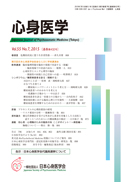Volume 51, Issue 7
Displaying 1-28 of 28 articles from this issue
- |<
- <
- 1
- >
- >|
-
Article type: Cover
2011Volume 51Issue 7 Pages Cover1-
Published: July 01, 2011
Released on J-STAGE: August 01, 2017
Download PDF (5871K) -
Article type: Cover
2011Volume 51Issue 7 Pages Cover2-
Published: July 01, 2011
Released on J-STAGE: August 01, 2017
Download PDF (5871K) -
Article type: Index
2011Volume 51Issue 7 Pages 597-
Published: July 01, 2011
Released on J-STAGE: August 01, 2017
Download PDF (68K) -
Article type: Index
2011Volume 51Issue 7 Pages 597-
Published: July 01, 2011
Released on J-STAGE: August 01, 2017
Download PDF (68K) -
Article type: Appendix
2011Volume 51Issue 7 Pages 598-
Published: July 01, 2011
Released on J-STAGE: August 01, 2017
Download PDF (98K) -
Article type: Article
2011Volume 51Issue 7 Pages 599-
Published: July 01, 2011
Released on J-STAGE: August 01, 2017
Download PDF (199K) -
Article type: Article
2011Volume 51Issue 7 Pages 600-607
Published: July 01, 2011
Released on J-STAGE: August 01, 2017
Download PDF (1030K) -
Article type: Article
2011Volume 51Issue 7 Pages 608-
Published: July 01, 2011
Released on J-STAGE: August 01, 2017
Download PDF (202K) -
Article type: Article
2011Volume 51Issue 7 Pages 609-614
Published: July 01, 2011
Released on J-STAGE: August 01, 2017
Download PDF (940K) -
Article type: Article
2011Volume 51Issue 7 Pages 615-620
Published: July 01, 2011
Released on J-STAGE: August 01, 2017
Download PDF (864K) -
Article type: Article
2011Volume 51Issue 7 Pages 621-628
Published: July 01, 2011
Released on J-STAGE: August 01, 2017
Download PDF (1194K) -
Article type: Article
2011Volume 51Issue 7 Pages 629-634
Published: July 01, 2011
Released on J-STAGE: August 01, 2017
Download PDF (802K) -
Article type: Article
2011Volume 51Issue 7 Pages 635-643
Published: July 01, 2011
Released on J-STAGE: August 01, 2017
Download PDF (1266K) -
Article type: Article
2011Volume 51Issue 7 Pages 644-649
Published: July 01, 2011
Released on J-STAGE: August 01, 2017
Download PDF (974K) -
Article type: Article
2011Volume 51Issue 7 Pages 650-658
Published: July 01, 2011
Released on J-STAGE: August 01, 2017
Download PDF (1399K) -
Article type: Article
2011Volume 51Issue 7 Pages 659-662
Published: July 01, 2011
Released on J-STAGE: August 01, 2017
Download PDF (494K) -
Article type: Article
2011Volume 51Issue 7 Pages 663-
Published: July 01, 2011
Released on J-STAGE: August 01, 2017
Download PDF (212K) -
Article type: Appendix
2011Volume 51Issue 7 Pages 664-665
Published: July 01, 2011
Released on J-STAGE: August 01, 2017
Download PDF (485K) -
Article type: Appendix
2011Volume 51Issue 7 Pages 667-669
Published: July 01, 2011
Released on J-STAGE: August 01, 2017
Download PDF (399K) -
Article type: Appendix
2011Volume 51Issue 7 Pages 670-671
Published: July 01, 2011
Released on J-STAGE: August 01, 2017
Download PDF (220K) -
Article type: Appendix
2011Volume 51Issue 7 Pages 672-674
Published: July 01, 2011
Released on J-STAGE: August 01, 2017
Download PDF (317K) -
Article type: Appendix
2011Volume 51Issue 7 Pages App1-
Published: July 01, 2011
Released on J-STAGE: August 01, 2017
Download PDF (38K) -
Article type: Appendix
2011Volume 51Issue 7 Pages App2-
Published: July 01, 2011
Released on J-STAGE: August 01, 2017
Download PDF (29K) -
Article type: Appendix
2011Volume 51Issue 7 Pages App3-
Published: July 01, 2011
Released on J-STAGE: August 01, 2017
Download PDF (173K) -
Article type: Appendix
2011Volume 51Issue 7 Pages App4-
Published: July 01, 2011
Released on J-STAGE: August 01, 2017
Download PDF (173K) -
Article type: Appendix
2011Volume 51Issue 7 Pages App5-
Published: July 01, 2011
Released on J-STAGE: August 01, 2017
Download PDF (173K) -
Article type: Appendix
2011Volume 51Issue 7 Pages App6-
Published: July 01, 2011
Released on J-STAGE: August 01, 2017
Download PDF (173K) -
Article type: Cover
2011Volume 51Issue 7 Pages Cover3-
Published: July 01, 2011
Released on J-STAGE: August 01, 2017
Download PDF (788K)
- |<
- <
- 1
- >
- >|
